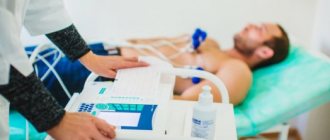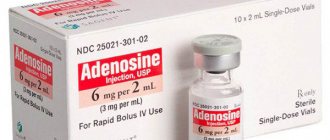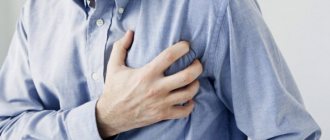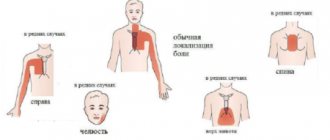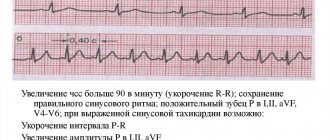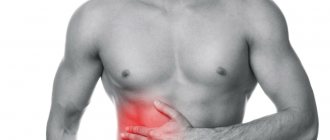- Difference between angina and tachycardia
- Causes of pathologies
- Symptoms
- Diagnostics
- Approaches to the treatment of angina and tachycardia
Angina and tachycardia are phenomena that are associated with heart rhythm disturbances. Both of them are common in people, mostly older people. Angina and tachycardia are accompanied by pain in the chest, but there are differences between them: they arise under the influence of different factors and develop according to different scenarios.
Difference between angina and tachycardia
Angina pectoris is a pain syndrome in the heart area, which is caused by circulatory disorders of the myocardium. It is not an independent disease - angina pectoris is a set of symptoms that indicate coronary heart disease.
Pain in the case of angina pectoris occurs at a time when the heart muscle experiences an acute lack of oxygen. Angina pectoris cannot be a normal variant.
Tachycardia is a type of arrhythmia in which the heart rate increases (reaches 90 beats or more). This phenomenon is associated with various diseases of the cardiovascular system. Tachycardia manifests itself in a strong beating of the heart muscle, a feeling of pulsation in the vessels of the neck, and dizziness.
Tachycardia in some cases is a variant of the norm. Thus, during stressful situations or increased physical activity, a person always feels a strong heartbeat. In children under 7 years of age, tachycardia is a physiological condition.
Treatment of diseases
To stop tachycardia, patients are advised to take medications that reduce heart rate. And to eliminate an attack of angina, Nitroglycerin is prescribed. Combination therapy with calcium channel blockers and beta-blockers is less commonly used.
The difference in the treatment of both diseases should be sought only when tachycardia is caused by other conditions. To treat anginal pain or increased heart rate, if these symptoms are components of the clinical symptom complex of IHD, a complex regimen is used. Patients are recommended to take statins (Rosuvastatin, Simvastatin, Atorvastatin) to reduce the level of low-density lipoproteins in the blood. Patients are prescribed angiotensin-converting enzyme inhibitors to maintain their cardiac function. The doctor also recommends taking blood thinning medications to prevent thrombosis. If Nitroglycerin does not help during an acute attack of angina, you should think about myocardial infarction. Therefore, the patient is called an ambulance and urgently hospitalized in the cardiology department.
Source: vsedavlenie.ru
Causes of pathologies
Angina and tachycardia develop for various reasons.
Causes of angina:
- insufficient oxygen supply to the heart muscle is the main cause of angina attacks; in turn, oxygen deficiency is caused by atherosclerosis of the coronary vessels;
- congenital heart defects;
- obesity;
- smoking;
- rheumatoid arthritis;
- thrombosis, thrombophlebitis;
- increased blood cholesterol levels;
- diabetes;
- inflammation of the coronary arteries of infectious origin;
- the presence of blood clots in the vessels, which is due to increased blood clotting ability;
- strong and frequent emotional shocks, prolonged stress;
- lack of mobility;
- hypertension;
- old age and associated changes occurring in all tissues, organs and systems of the body.
Causes of tachycardia:
- heart failure – both acute and chronic;
- myocardial infarction;
- bacterial endocarditis;
- myocarditis;
- heart muscle defects;
- cardiomyopathy;
- disorders of the autonomic nervous system;
- prolonged bleeding and vomiting;
- hormonally active pituitary or adrenal tumors;
- psycho-emotional stress;
- deficiency of magnesium and potassium in the body;
- bad habits – drinking alcohol and smoking;
- sudden change in body position.
Most often, the development of angina or tachycardia is influenced by only one provoking factor. In some cases, a combination of several reasons may contribute to this.
How do pathologies manifest themselves?
Manifestations can be divided as follows:
- Angina pectoris. It causes the following sensations: Sudden chest pain. It has a burning, squeezing, pressing character. Such painful sensations were previously called “angina pectoris.”
- Inability to breathe. The patient feels as if a stone has been placed on his chest and he cannot open his lungs.
- Swelling of the neck veins and redness of the face.
- Interruptions in the functioning of the heart. They arise when ari joins the chest. These sensations occur when the heartbeat accelerates to 90 beats per minute or more.
Symptoms
Each of the pathologies has its own clinical picture.
Manifestations of angina
Angina pectoris manifests itself in the following symptoms:
- compressive pain that appears in the chest area, as well as under the ribs;
- burning and heaviness in the chest;
- labored breathing;
- feeling of tightness in the chest area;
- radiating pain to the left arm and shoulder blade, sometimes to the cervical spine and jaw;
- general fatigue;
- panic attacks, fear of death.
The pain may last from 5 to 40 minutes. If it does not stop within 20 minutes, it may indicate that the person is having an acute myocardial infarction.
Less characteristic of angina, but sometimes occurring, are the following symptoms:
- decrease or increase in heart rate;
- pale skin;
- pain and shortness of breath after exercise.
Symptoms appear depending on what form of angina the patient has. It can be sudden, unstable and stable.
Manifestations of tachycardia
Tachycardia is characterized by the following manifestations:
- a sharp increase in heart rate, which is usually paroxysmal in nature;
- chest pain of various types - pulling, pressing, burning;
- general weakness;
- fainting state;
- dyspnea;
- anxiety, feeling of panic;
- darkening of the eyes;
- coldness in the extremities;
- paleness of the skin;
- feeling of lack of oxygen;
- dizziness.
The average duration of one attack of tachycardia is about 20 minutes.
What is the difference between angina pectoris and cardiac arrhythmia?
Arrhythmia and angina pectoris are among the most common cardiac pathologies. They are interconnected, but their symptoms are significantly different. The reason for this is that ailments are of different nature. Arrhythmia is a disturbance of the heart rhythm, a change in the frequency and sequence of beats (contractions). Occurs against the background of exposure to unfavorable factors, which include the following:
- diseases of the cardiovascular system;
- arterial hypertension;
- climacteric disruptions in the body;
- traumatic brain injury;
- pathologies of the thyroid gland;
- adrenal gland diseases;
- frequent stress;
- alcohol abuse;
- smoking;
- physical and nervous stress;
- intoxication;
- influence of drugs.
Angina pectoris is expressed in heart attacks that occur as a result of arrhythmic disorders.
Angina is provoked by a lack of oxygen supplied to the heart muscle along with blood, but in limited quantities. That part of the muscle that does not receive enough oxygen is damaged, weakened, and processes of necrosis can be observed in it. Signs of angina and cardiac arrhythmia manifest themselves in different ways. Failures in the contraction of the heart muscle (arrhythmia) can take the following forms:
- Sudden attacks. A person may not be bothered by anything, but under the influence of unfavorable factors that cause stress, he experiences sudden attacks of illness - the temperature rises, pain appears in the heart area, nausea and dizziness are felt, even to the point of loss of consciousness. This condition is very dangerous, and it is imperative to call an ambulance. Before her arrival, first aid measures should be taken.
- No signs of arrhythmia. In this case, disruptions in heart rhythm do not affect people’s well-being in any way. Violations can only be detected during a routine inspection and examination. Such asymptomatic arrhythmia most often occurs in young people and is easily eliminated without threatening the life and health of patients.
- Constant malaise. Arrhythmia often causes chronic fatigue and poor health. The patient exhibits the following signs of the disease: severe general weakness, fever, numbness of the upper extremities, nausea. General malaise for a long time causes the patient to feel fear and helplessness. Panic in such a situation only aggravates the situation and increases the severity of arrhythmia symptoms. It is very important to maintain peace of mind and consult a specialist in a timely manner. Under no circumstances should you drink alcohol if you have heart rhythm disturbances; it can cause serious complications.
Arrhythmia is a dangerous disease as it can lead to ventricular fibrillation of the heart. With this disease, sudden death can occur. The described signs of the disease refer to general symptoms. The clinical picture of arrhythmia for each individual patient is individual, because the development of the pathology can be influenced by various factors. In addition, a person’s condition depends on the type of arrhythmia, the characteristics of its course and the presence of concomitant diseases. Arrhythmia is also classified by type, each of which has its own symptoms:
- With bradycardia (slow heartbeat), the patient feels lethargic and drowsy. The body is very weakened, its performance is significantly reduced. A person is stressed and constantly wants to sleep.
- With tachycardia (rapid rhythm), the patient's activity and excitability increase. Feeling restless is accompanied by shortness of breath and chest pain.
- With atrial fibrillation and extrasystole (irregular heartbeat), frequent and sudden changes in pressure occur, there is a feeling of constant nausea and dizziness. Fainting may occur. The pain syndrome affecting the heart area becomes very severe.
With angina pectoris, the patient suffers from burning and sharp pain in the chest, which spreads to the abdomen, left shoulder and arm, and to the lower jaw. Some people experience increased sweating and may experience nausea, leading to vomiting. The patient's breathing is slow, the intervals between breaths can last up to 2 seconds or more. The following typical symptoms are typical for angina:
- pain attacks during inhalation and exhalation;
- squeezing and pinching pain with accompanying burning sensation in the chest;
- difficulty breathing due to lack of air;
- discomfort when moving the forearm and left hand.
The following are considered atypical symptoms of angina:
- back pain;
- painful sensations in the lower jaw, radiating to the teeth of the lower row;
- weakening of the body;
- digestive disorders - heartburn, colitis, nausea, vomiting;
- pale skin;
- Irregular heart rhythm.
Such phenomena, uncharacteristic for this heart disease, can occur against the background of exacerbation of pathologies of the gastrointestinal tract, lungs, and gallstone disease.
Attacks of the disease have different forms:
- An attack of angina pectoris. Occurs as a result of stress, increased emotional arousal, severe intoxication or significant physical activity. Sharp pain in the chest appears suddenly and goes away quite quickly.
- Unstable angina. We are talking about those cases when an attack begins in a person who is in a calm state and is accompanied by acute pain in the heart area. The patient begins to experience a feeling of suffocation; he cannot breathe deeply. Such attacks can last 10 minutes or more. If you feel unwell for a long time, you should seek help from a cardiologist, since this form of angina may indicate the development of myocardial infarction.
- Variant (vasospastic) angina. The attacks last from 2 to 5 minutes and begin at night or in the morning, when the person is resting. Violations in this case are provoked by spasm of the coronary arteries.
Signs of angina and arrhythmia should not be ignored, as they indicate abnormalities in the functioning of the most important organ - the heart. If left untreated and inactive, such disorders can lead to serious complications and even death.
An arrhythmia is a heart rhythm disorder that occurs when electrical impulses do not function properly and cause the heart to beat too fast, slow, or irregularly. As a rule, arrhythmia is not dangerous and occurs quite often. Some people experience short-term interruptions in the functioning of the heart - loss of one or more contractions, rapid heartbeat, etc. however, there are types of arrhythmia that threaten human health and life.
Because arrhythmia can cause serious consequences in some groups of people, it is important to recognize it early. Symptoms of arrhythmia are as follows:
Abnormally fast heartbeat;
Condition close to fainting, loss of consciousness.
The normal heart rate of an adult is 60-100 beats per minute at rest. In children, these figures are slightly higher - more than 100 beats, and in infants - 140-160 beats per minute.
High blood pressure;
Excessive consumption of alcohol, nicotine and caffeine;
Factors such as:
Insufficient blood supply. Reduced blood flow to the heart impairs the cells' ability to generate electrical impulses;
Damage or complete destruction of the heart muscle, which leads to a change in the paths of electrical impulses;
Cardiac ischemia;
Cardiomyopathy, in which the walls of the ventricles and atria stretch and thin;
Damage to the heart valves.
The risk of developing arrhythmias in different categories of patients is due to the following factors:
Diseases of the thyroid gland, in which there is an increased production of hormones, an increase in the body's metabolism, as a result of which the heartbeat becomes irregular;
High blood pressure, which causes thickening of the wall of the left ventricle, which in turn changes the nature of the passage of impulses through it;
Electrolyte disturbances. Potassium, magnesium, sodium and calcium, which are conductors of electrical impulses, can cause the development of arrhythmia due to their excess or insufficient content in the body;
Abuse of stimulants. Caffeine, nicotine, amphetamine, cocaine are psychostimulants and can lead to severe heart rhythm disturbances.
Daily ECG using a portable recorder. This method allows you to record the electrical activity of the heart during wakefulness and sleep;
Tests with physical activity, allowing to identify types of arrhythmias that appear only with increased activity. As a rule, they use exercise bikes, treadmills, and in some cases, medications that stimulate cardiac activity;
Tilt table test. It is used in cases where the patient often loses consciousness. Monitoring of heart function is carried out in a horizontal position, and then in a vertical position;
Electrophysiological study and mapping. It is carried out using thin electrodes inserted into the heart cavity. This is the most accurate test that allows you to diagnose most types of arrhythmias. In addition, with the help of EPI, the source of arrhythmia can be eliminated. Thanks to thermal radiofrequency effects, EPI can eliminate most supraventricular and some subventricular tachycardias.
Treatment of arrhythmia is carried out under strict medical supervision. As a rule, pacemakers are used for this, which allow you to equalize the heart rhythm using artificial electrical impulses. Surgery is indicated only for patients with coronary heart disease and those who have suffered a myocardial infarction.
Causes of angina development:
Thickening and loss of elasticity of the walls of blood vessels associated with age-related changes in the body;
High cholesterol;
High blood pressure;
Smoking, drinking alcohol, eating large amounts of food;
Excessive physical activity;
Discomfort or pain in the chest, radiating to the left side of the body: shoulder, arm, lower jaw, neck;
State of anxiety, fear;
Sensations that get worse when lying down.
It must be remembered that angina has similar symptoms to other diseases: stomach ulcers, cholelithiasis, heart attack. To distinguish angina pectoris, it is necessary to pay attention to the following factors that are not typical for this disease:
Constant aching pain;
Taking nitroglycerin does not alleviate the condition, but can provoke more severe pain;
The appearance of pain is not associated with increased physical activity;
The duration of attacks is 15-20 minutes or more.
The difference between an attack of angina and an impending myocardial infarction is that with angina, it is enough to reduce physical activity to feel better. The pre-infarction condition is characterized by severe, prolonged pain. If angina attacks last longer than usual, you should urgently consult a cardiologist.
According to the course of the disease, the following types of angina are distinguished:
Stable, lasting for a long time without changes;
Unstable, progressive. Unstable angina can cause cardiac arrest or myocardial infarction.
Treatment of angina pectoris is complex. The patient needs to monitor cholesterol levels, adhere to a strict diet and eliminate saturated fats from the diet. It is recommended to eat more vegetables and fruits, fish and foods rich in antioxidants. Drug therapy involves taking medications that dilate blood vessels and improve blood flow. Calcium channel blockers are also widely used.
Coronary heart disease develops due to insufficient oxygen supply to the heart muscle. The most common cause of the disease is atherosclerosis of the coronary arteries - narrowing of their lumen and the formation of plaques. IHD has several manifestations: myocardial infarction, angina pectoris, arrhythmia.
IHD is more common in men than in women. The reason for this is that female sex hormones protect blood vessels from atherosclerotic damage. After the onset of menopause, the risk of developing coronary artery disease and myocardial infarction in women increases.
There are the following forms of IHD:
Angina pectoris caused by exercise or stress. The patient suffers from shortness of breath and experiences chest pain;
Unstable angina. Characterized by attacks of increasing strength and accompanied by new symptoms. May indicate a pre-infarction condition;
Arrhythmic. This form occurs suddenly and is manifested by cardiac arrhythmia, atrial fibrillation;
Myocardial infarction, characterized by the death of a section of the heart muscle. Most often caused by plaque breaking away from the artery wall or blockage of the artery by a blood clot;
Sudden cardiac death. Occurs due to a sharp decrease in blood supply due to blockage of a large artery.
Symptoms of IHD vary depending on the type of disease. With angina pectoris, the patient experiences pressing pain radiating to the left side of the body and shortness of breath when climbing stairs. The arrhythmic form is characterized by palpitations, irregular heart rhythm and shortness of breath. Myocardial infarction is manifested by severe, prolonged pain in the chest, which cannot be relieved by conventional means.
The reasons for the development of IHD are as follows:
Blood pressure exceeding 140/90 mm Hg. Art.;
Sedentary lifestyle;
Poor nutrition, excess weight;
Use of tobacco, alcohol;
Nervous tension, frequent stress.
Diagnosis of coronary artery disease consists of ultrasound examination and coronary angiography, which allows one to accurately determine the location and degree of narrowing of the coronary artery.
To date, there are no precedents for a complete cure for IHD. However, modern means and methods make it possible to control and slow down the course of the disease. Treatment of IHD is aimed at improving blood supply to the myocardium. There are several methods for this – both conservative and surgical. Taking medications, following a diet and moderate physical activity can help in the initial stages of the disease. More serious stages of the disease may require surgical correction methods - coronary artery bypass grafting, balloon angioplasty, coronary artery stenting, etc.
We learn to recognize angina pectoris and cardiac arrhythmia.
Arrhythmia and angina pectoris are the most common cardiac pathologies, related to each other, but with different symptoms. This is due to the fact that these diseases have different natures. Thus, arrhythmia is a consequence of a disturbance in the heart rhythm, a change in the frequency and sequence of beats (contractions). It occurs due to the fact that there were diseases of the cardiovascular system or the person has arterial hypertension. Sometimes arrhythmia occurs in women during menopausal disruptions in the body. Traumatic brain injury can also cause arrhythmia. What can we say about frequent stress, smoking or physical and nervous stress.
Angina pectoris is expressed in heart attacks, which are a consequence of arrhythmic disorders. Angina pectoris can be triggered by a lack of oxygen - a part of the muscle that does not receive enough oxygen becomes damaged, weakened, and processes of necrosis can be observed in it.
Signs of arrhythmia and angina pectoris manifest themselves in different ways. Often, due to arrhythmia, a person experiences chronic fatigue and poor health. People complain of general weakness, fever, numbness of the upper extremities, and nausea. After some time, the patient develops a feeling of fear and helplessness. And then panic sets in, which only worsens the situation and increases the severity of the symptoms of arrhythmia. Therefore, remember: it is important to maintain peace of mind and be sure to consult a doctor in time. If you have heart rhythm disturbances, you should completely stop drinking alcohol. And smoking is a bad help here - the peace that you are looking for by smoking cigarette after cigarette is only an appearance.
Arrhythmia cannot be started - it can be a harbinger of a more serious disease - ventricular fibrillation of the heart. And this is already a chance to die suddenly. The general signs of arrhythmia were discussed above. Moreover, the clinical picture of arrhythmia for each individual patient is individual. Also, a person’s condition will depend on various factors, the presence or absence of concomitant diseases.
Arrhythmia is divided into several types, each of which has its own symptoms. So, with bradycardia, the patient feels a slow heartbeat, lethargy and drowsiness. With tachycardia, on the contrary, there is a rapid heartbeat, increased excitability, restlessness, shortness of breath and chest pain. With atrial fibrillation, people experience irregular heartbeats, sudden changes in blood pressure, and a feeling of constant nausea and dizziness. With angina pectoris, the patient experiences burning and acute pain in the chest, sweating increases, and even vomiting may occur.
But with angina pectoris, attacks of pain occur during inhalation and exhalation; squeezing and pinching pain with accompanying burning sensation in the chest; difficulty breathing due to lack of air. Sometimes there is pain in the back; digestive disorders - heartburn, colitis, nausea, vomiting.
Diagnostics
If angina is suspected, the patient is prescribed the following diagnostic measures:
- general blood and urine analysis;
- blood chemistry;
- electrocardiogram;
- 24-hour Holter monitoring;
- tests with dosed physical activity;
- psycho-emotional stress test;
- coronary angiography;
- echocardiography;
- positron emission tomography;
- scintigraphy of the heart muscle;
- transesophageal atrial stimulation.
Tachycardia is diagnosed using the following measures:
- complete blood count and blood test for thyroid hormones;
- electrocardiography;
- echocardiography;
- 24-hour Holter ECG monitoring;
- electrophysiological study.
After identifying a deviation, the specialist prescribes an adequate course of treatment.
Symptoms of tachycardia
One of the characteristic clinical syndromes accompanying pathological tachycardia of the heart is angina pectoris: discomfort and pain of a squeezing and pressing nature, localized behind the sternum, radiating to the left arm, epigastric zone, neck, jaw.
In addition to angina syndrome, the clinical picture of tachycardia includes palpitations (more than 15% of patients complain about this), panic attacks, shortness of breath, dizziness, fainting, signs of heart failure, arterial hypotension and transient ischemic attacks, and dyspnea.
The severity of symptoms depends on the type of tachycardia. A more striking symptom complex is characterized by paroxysmal tachycardia with a paroxysmal course, a sharp increase in heart rate up to 200–250 times per minute. The attack can last several days.
Unlike paroxysmal, the symptoms of sinus tachycardia increase more gradually, and the frequency of myocardial contractions is usually up to 130 beats per minute (at rest). Sinus tachycardia occurs with pathology of the sinoatrial node; can develop due to an imbalance in the autonomic regulation of the heart.
Is this pathology?
A frequently asked question with sinus tachycardia is what: a benign adaptation process or a manifestation of pathology? Many cardiologists classify the variant of sinus tachycardia as normal, answering patients’ questions about sinus tachycardia, saying that this form does not require special treatment if the tachyarrhythmias are not accompanied by changes in hemodynamics and are asymptomatic.
Approaches to the treatment of angina and tachycardia
Correction of angina pectoris
To correct the condition, a patient with angina pectoris is prescribed measures aimed at treating the diseases that caused this phenomenon, as well as eliminating factors contributing to the development of atherosclerosis.
The following medications are used for angina:
- drugs that prevent thrombosis (acetylsalicylic acid, Clopidogrel);
- beta-blockers, which prevent the effect of stress hormones on the heart muscle and reduce the myocardial oxygen demand (Metaprolol);
- nitrates, which dilate veins and reduce the load on the heart muscle (Nitroglycerin).
During an attack of angina, the patient should immediately stop physical activity and sit down. In this case, you should put a Nitroglycerin tablet under your tongue or use a spray that contains this substance (Isoket).
Additional measures that help in the fight against angina attacks are:
- normalization of body weight;
- rejection of bad habits;
- adherence to a special diet.
As for the therapeutic diet, first of all, the patient needs to give up foods that increase the level of bad cholesterol in the blood and thereby increase the risk of developing atherosclerosis. These are fatty meats, quickly digestible carbohydrates, semi-finished products, sweets, smoked meats, and flour products. You should also limit the amount of salt you consume.
Patients suffering from angina pectoris should eat as many foods as possible that contain potassium. These are mushrooms, tomatoes, raisins, prunes, dairy products, seafood, black currants.
For angina pectoris, it is useful to drink hawthorn tea. To prepare it, you need to take 4 tablespoons of dried raw materials, pour a liter of boiling water and leave for 20 minutes. Drink instead of regular tea.
Therapeutic measures for tachycardia
For tachycardia, medications are prescribed based on the cause that caused the heart rhythm disturbance. Patients are recommended:
- sedatives (valerian root, Novo-Passit, Diazepam);
- antiarrhythmic drugs (Anaprilin, Ratmilen);
- long-term drugs that stabilize the nervous system (Atenol, Concor).
Also, for tachycardia, physiotherapeutic procedures are recommended, for example, reflexology and electrical impulse therapy.
Traditional methods can also be used to correct the patient's condition. These include the following recipes:
- Combined herbal infusion. To prepare it, you need to take 2 tablespoons of hawthorn, peppermint and motherwort and 1 tablespoon of lily of the valley. Mix all the ingredients, take a tablespoon of the mixture and pour this amount into 300 ml of water. Put on fire, bring to a boil. Let the product brew for 1.5 hours, then strain. Take 3-5 times a day, 1-2 tablespoons.
- Honey tincture. You need to prepare a liter of natural honey, 10 lemons and 10 heads of garlic. The garlic is crushed and the juice is squeezed out of the lemons. The juice, garlic pulp and honey are mixed and left in a tightly closed container for 10 days. Use the finished product 4 times a day, slowly dissolving one teaspoon of the composition.
- Gorse seeds. You need to grind the raw materials and consume the resulting mass orally, one-third of a teaspoon up to three times a day.
First aid for an attack of tachycardia is to free the chest area and neck from clothing. You can give Corvalol or motherwort tincture. The patient's face should be wiped with a cloth soaked in cold water.
Angina and tachycardia are conditions that cause heart rhythm disturbances. They are associated with different reasons and are manifested by signs characteristic of each type of deviation. To prevent repeated attacks of angina or tachycardia, it is necessary to diagnose and treat the diseases that provoked them.
Types of angina
There are three of them. These are stable, unstable and variant angina. The first case is the most common. It occurs mainly due to atherosclerosis and manifests itself during physical activity. It is divided, in turn, into four classes, each of which indicates the stage of development of the disease. With the first, for example, pain occurs quite rarely, usually with significant physical exertion. This is followed by class 2 angina, the signs of which (attacks of pain) appear simply when walking quickly or climbing stairs. At the third stage, problems may arise even when going outside in cold weather and doing little physical activity.
Well, the most unfavorable situation is functional class 4 angina. Its signs include the inability to perform any physical work without discomfort. But pain can still occur even at rest. In general, this is, of course, a pre-infarction state. Unstable angina almost immediately falls under the same definition. Its symptoms are usually the following:
1. A patient with stable angina experiences an increase in the frequency and severity of attacks.
2. Painful sensations occur at rest.
3. Post-infarction angina occurs, the symptoms of which may appear within two weeks after the illness.
4. The disease occurs unexpectedly - for the first time in life.
All of the above are conditions of unstable angina and a reason for emergency hospitalization. Call an ambulance immediately! But what are the signs of angina that indicate it is unstable? First of all, this is an attack at rest or with little physical activity. Secondly, one nitroglycerin tablet does not help - you have to take at least two. And thirdly, the attacks are longer than with stable angina.
Causes of the disease and symptoms of attacks
The leading cause of angina pectoris is atherosclerosis - cholesterol accumulations on the walls of the arteries, reducing or blocking their lumen. Oxygen deficiency changes metabolism in myocardial tissues; toxins are formed from under-oxidized breakdown products, which enter the blood and poison the body. The causes of illness can be changeable or unchangeable. Their description is presented in the table.
- age after 50-60 years;
- heredity;
- chronic diseases and heart disease.
- physical inactivity;
- unhealthy food;
- excess weight;
- addiction to cigarettes or alcohol;
- emotional stress;
- high blood pressure;
- increased blood viscosity.
Angina pectoris manifests itself in attacks of varying frequency and intensity lasting up to 15 minutes. A characteristic symptom is discomfort in the chest, which manifests itself as heaviness, squeezing, pain, burning. The pain can radiate to the forearm, left arm, under the shoulder blade, or to the stomach area. During an attack, patients experience the following symptoms:
- rise in blood pressure;
- dizziness and weakness;
- headache;
- dyspnea;
- sweating;
- sensation of uneven heartbeat.
Taking medications for angina and arrhythmia is mandatory. Based on the characteristics of the course and severity of the disease, the cardiologist selects the dose. More often, several types of pharmacological agents are prescribed, complementing the effect of each other. The treatment plan for angina pectoris includes the following groups:
- antianginal drugs - nitrates, beta-blockers, calcium antagonists;
- antiplatelet agents;
- anti-sclerotic drugs (statins);
- diuretics;
- vitamins.
The effect of eliminating a painful attack during angina pectoris is based on relaxing the vascular walls and improving blood circulation in the ischemic area, relieving spasm of the heart muscle. Nitrates have a short or long-lasting effect. Side effects include severe headaches and severe hypotension. Names of commonly used drugs:
- "Nitroglycerine". The medicine penetrates faster through the mucous membranes. Taking 1 tablet of Nitroglycerin sublingually stops an attack of angina.
- “Isosorbide dinitrate” (“Nitrosorbide”, “Izomac”). It acts 10-20 minutes after administration.
- “Isosorbide mononitrate” (“Isomonit”, “Pentacard”) with a long-lasting effect. Taken 1-2 times a day to prevent an attack.
Nitrates are contraindicated in low blood pressure, since the rapid vasodilatory effect provokes fainting and collapse.
Beta blockers that lower the heart rate reduce the load on the myocardium. Helps with high blood pressure. The effect is expressed during physical activity. Medicines such as Atenolol and Anaprilin are taken. You need to start treatment with small doses.
As a result of blocking the excessive intake of calcium ions, vascular spasm is eliminated, heart rate decreases, and blood circulation through the coronary vessels improves. The drugs "Nifedipine", "Verapamil", "Diltiazem" are taken 1-2 times a day. Medicines require careful dosage selection and assessment of compatibility with other medications. They exhibit a wide range of side effects. Contraindicated for people with impaired liver and kidney function, with unstable blood pressure.
The diuretic effect quickly eliminates swelling from the spasmodic walls of the arteries. Prescribed in combination with other drugs for arterial hypertension and angina pectoris. Chlorthalidone is taken once a day, increasing the dose for severe attacks. Does not flush out sodium and potassium as intensely as Lasix, which is prescribed only in emergency situations.

